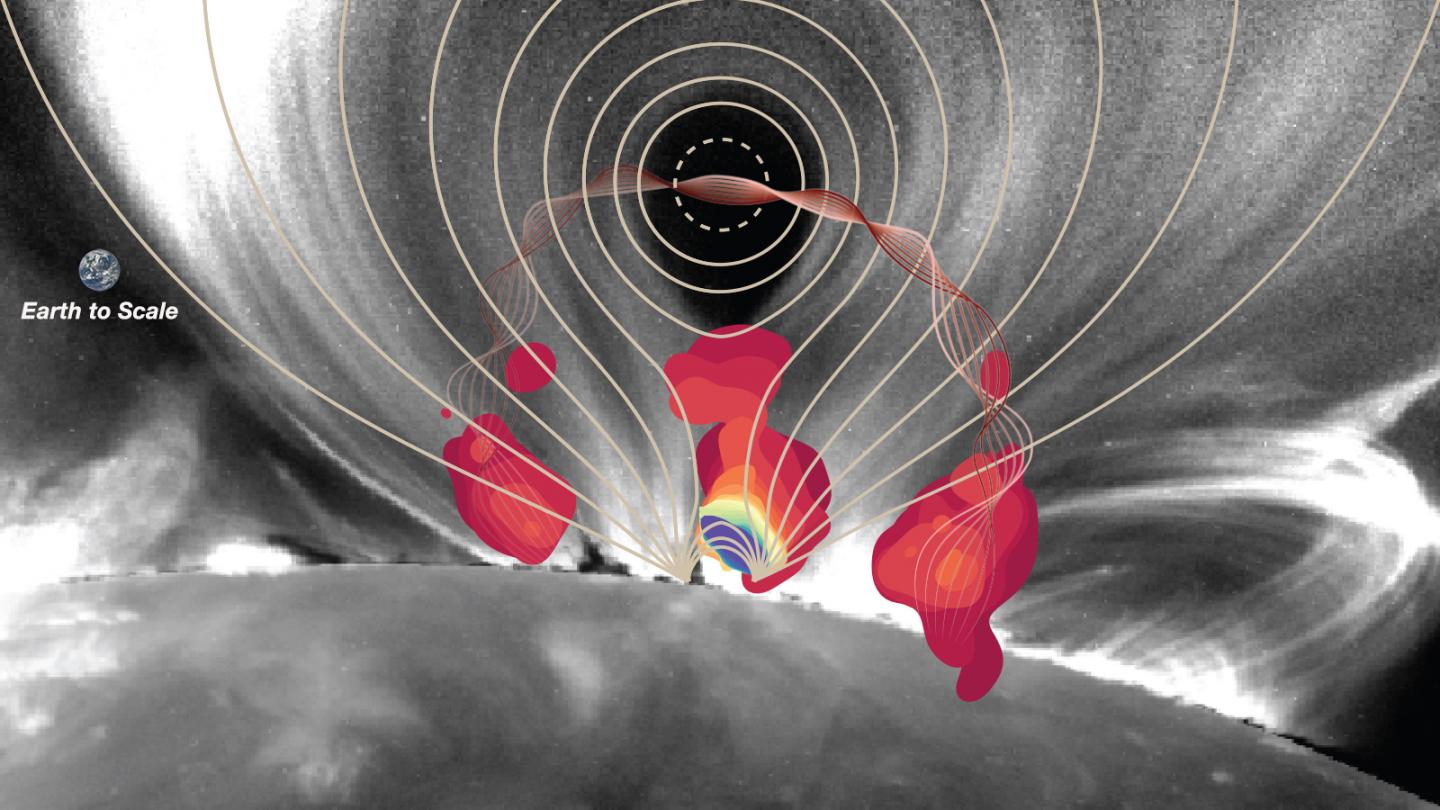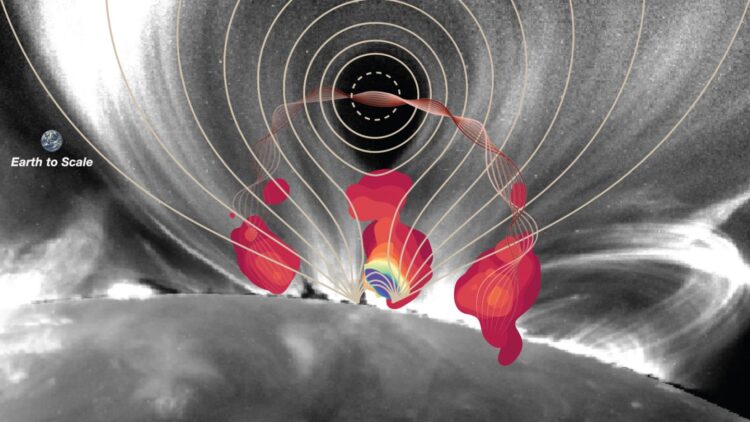An international research team has presented a new look inside the “central engine” of a solar flare accompanied by an eruption, revealing an enormous electric current “sheet,” offering the first measurements characterizing the magnetic field.

Credit: CSTR/NJIT, B. Chen, S. Yu; NASA Solar Dynamics Observatory
In a study published in Nature Astronomy, an international team of researchers has presented a new, detailed look inside the “central engine” of a large solar flare accompanied by a powerful eruption first captured on Sept. 10, 2017 by the Owens Valley Solar Array (EOVSA) — a solar radio telescope facility operated by New Jersey Institute of Technology’s (NJIT) Center for Solar-Terrestrial Research (CSTR).
The new findings, based on EOVSA’s observations of the event at microwave wavelengths, offer the first measurements characterizing the magnetic fields and particles at the heart of the explosion. The results have revealed an enormous electric current “sheet” stretching more than 40,000 kilometers through the core flaring region where opposing magnetic field lines approach each other, break and reconnect, generating the intense energy powering the flare.
Notably, the team’s measurements also indicate a magnetic bottle-like structure located at the top of the flare’s loop-shaped base (known as the flare arcade) at a height of nearly 20,000 kilometers above the Sun’s surface. The structure, the team suggests, is likely the primary site where the flare’s highly energetic electrons are trapped and accelerated to nearly the speed of light.
Researchers say the study’s new insight into the central engine that drives such powerful eruptions may aid future space weather predictions for potentially catastrophic energy releases from solar flares — the solar system’s most powerful explosions, capable of severely disrupting technologies on Earth such as satellite operations, GPS navigation and communication systems, among many others.
“One of the major goals of this research is to better understand the fundamental physics of solar eruptions,” said Bin Chen, the paper’s lead author and professor of physics at NJIT. “It has been long suggested that the sudden release of magnetic energy through the reconnection current sheet is responsible for these major eruptions, yet there has been no measurement of its magnetic properties. With this study we’ve finally measured the details of the magnetic field of a current sheet for the first time, giving us a new understanding of the central engine of the Sun’s major flares.”
“The place where all the energy is stored and released in solar flares has been invisible until now. … To play on a term from cosmology, it is the Sun’s ‘dark energy problem,’ and previously we’ve had to infer indirectly that the flare’s magnetic reconnection sheet existed,” said Dale Gary, EOVSA director at NJIT and co-author of the paper. “EOVSA’s images made at many microwave frequencies showed we can capture radio emissions to illuminate this important region. Once we had that data, and the analysis tools created by co-authors Gregory Fleishman and Gelu Nita, we were able to start analyzing the radiation to enable these measurements.”
Earlier this year in the journal Science, the team reported it could finally provide quantitative measurements of the evolving magnetic field strength directly following the flare’s ignition.
Continuing their investigation, the team’s latest analysis combined numerical simulations performed at Center for Astrophysics | Harvard & Smithsonian (CfA) with EOVSA’s spectral imaging observations and multiwavelength data — spanning radio waves to X-rays — collected from the X8.2-sized solar flare. The flare is the second largest to have occurred from the past 11-year solar cycle, occurring with a fast coronal mass ejection (CME) that drove a large-scale shock in the upper solar corona.
Among the study’s surprises, the researchers found that the measured profile of the magnetic field along the flare’s current sheet feature closely matched predictions from the team’s numerical simulations, which were based on a well-known theoretical model for explaining solar flare physics, first proposed in the 1990s with an analytical form.
“It surprised us that the measured magnetic field profile of the current sheet beautifully matched the theoretical prediction made decades ago,” said Chen.
“The force of the Sun’s magnetic field plays a key role in accelerating plasma during an eruption. Our model was used for computing the physics of the magnetic forces during this eruption, which manifests as a highly twisted ‘rope’ of magnetic field lines, or magnetic flux rope,” explained Kathy Reeves, astrophysicist at CfA and co-author of the study. “It is remarkable that this complicated process can be captured by a straightforward analytical model, and that the predicted and measured magnetic fields match so well.”
The simulations, performed by Chengcai Shen at CfA, were developed to numerically solve governing equations for quantifying the behavior of electrically conducting plasma throughout the flare’s magnetic field. By applying an advanced computational technique known as “adaptive mesh refinement,” the team was able to resolve the thin reconnection current sheet and capture its detailed physics at superfine spatial scales to below 100 kilometers.
“Our simulation results match both the theoretical prediction on magnetic field configuration during a solar eruption and reproduce a set of observable features from this particular flare, including magnetic strength and plasma inflow/outflows around the reconnecting current sheet,” Shen noted.
Shocking Measurements
The team’s measurements and matching simulation results revealed that the flare’s current sheet features an electric field that produces a shocking 4,000 volts per meter. Such a strong electric field is present over a 40,000-kilometer region, greater than the length of three Earths placed together side by side.
The analysis also showed a huge amount of magnetic energy being pumped into the current sheet at an estimated rate of 10-100 billion trillion (1022-1023) joules per second — that is, the amount of energy being processed at the flare’s engine, within each second, is equivalent to the total energy released by the explosion of about a hundred thousand of the most powerful hydrogen bombs (50-megaton-class) at the same time.
“Such an enormous energy release at the current sheet is mind-blowing. The strong electric field generated there can easily accelerate the electrons to relativistic energies, but the unexpected fact we found was that the electric field profile in the current sheet region did not coincide with the spatial distribution of relativistic electrons that we measured,” said Chen. “In other words, something else had to be at play to accelerate or redirect these electrons. What our data showed was a special location at the bottom of the current sheet — the magnetic bottle — appears to be crucial in producing or confining the relativistic electrons.”
“While the current sheet seems to be the place where the energy is released to get the ball rolling, most of the electron acceleration appears to be occurring in this other location, the magnetic bottle. … Similar magnetic bottles are under development for confining and accelerating particles in some laboratory fusion reactors.” added Gary. “Others have proposed such a structure in solar flares before, but we can truly see it now in the numbers.”
Approximately 99% of the flare’s relativistic electrons were observed congregating at the magnetic bottle throughout the duration of the five-minute-long emission.
For now, Chen says the group will be able to apply these new measurements as a comparative baseline to study other solar flare events, as well as explore the exact mechanism that accelerates particles by combining the new observations, numerical simulations and advanced theories. Because of the breakthrough capabilities of EOVSA, NJIT was recently selected to participate in a joint NASA/NSF DRIVE Science Center Collaboration on Solar Flare Energy Release (SolFER).
“Our goal is to develop a full understanding of solar flares, from their initiation until they finally spray out highly energized particles into the solar wind, and eventually, into the space environment of Earth,” said Jim Drake, professor of physics at the University of Maryland and principal investigator of SolFER who was not involved in this study.
“These first observations are already suggesting that relativistic electrons might be trapped in a large magnetic bottle produced as the magnetic fields of the corona ‘reconnect’ to release their energy. … The EOVSA observations will continue helping us unravel how the magnetic field drives these energetic electrons.”
“Further investigating the role of the magnetic bottle in particle acceleration and transport will require more advanced modeling to compare with EOVSA’s observations,” said Chen. “There are certainly huge prospects out there for us to study that address these fundamental questions.”
###
DOI 10.1038/s41550-020-1147-7 *Full author list: Bin Chen, Chengcai Shen, Dale E. Gary, Katharine K. Reeves, Gregory D. Fleishman, Sijie Yu, Fan Guo, Säm Krucker, Jun Lin, Gelu M. Nita, Xiangliang Kong.
Media Contact
Deric Raymond
[email protected]
Related Journal Article
http://dx.





